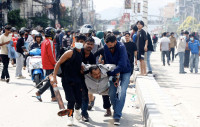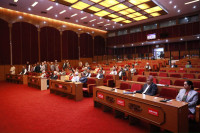Columns
Lessons learnt from the Bara-Parsa rainstorm reconstruction programme
The Army-led programme showed how Nepal has the capacity and capability to satisfactorily complete reconstruction..jpg&w=900&height=601)
Shrijan Bahadur Malla
Unlike after 2015 earthquake, the response during the tornado that battered Bara and Parsa was swift. This was followed by relatively quick reconstruction efforts. Thanks to the Nepal Army, the government has successfully reconstructed 869 houses destroyed by the rainstorm within 97 days. The army not only completed the reconstruction in a short period but also built eco-friendly, earthquake-proof, weatherproof and technically sound houses. Besides, the reconstruction efforts exhausted only 89 percent of the total budget, saving some Rs60,000. It also includes the extra cost incurred during electrification and painting, which was previously not included in the budget estimate. This is a remarkable achievement and the authorities could find a lesson or two for the future.
Centralised authority is an obstacle for such a mega project with a limited time framework. All works have to be pursued concurrently. Therefore, various committees were formed keeping this in mind. At the top was the Janta Awas Karyadal to take overall command of reconstruction. Two sub-working groups—Parsa Karyadal and Bara Karyadal—were to report to the Janata Awas Karyadal. Below the Parsa and Bara Karyadal were 12 technical clusters. Similarly, at the provincial level, the Assisting and Coordination Committee was formed under the chairmanship of the province's First Secretary to ease the decision-making process. Besides, at the district level, District Disaster Management Committees and Verification Committees were activated respectively.
What’s more, the government delegated specific tasks to respected authorities such as verifying the number of houses, adjusting the model of the house, procuring construction materials directly from suppliers, building homes in public land for squatters and so on. Such delegation of authority didn't only economise the time of construction but also leveraged on-ground decision making.
It took a week for the Nepal Army to finalise the detailed plan of action in the aftermath of the disaster. This included studying and modifying the houses designed by the Urban Development Ministry until material estimation, human resource requirement, construction tools, equipment requirement, timeline calculation, troops' deployment were all thought-out. And it was the result of such meticulous planning that the reconstruction process went about as smoothly as possible.
Yet, the management of human resource as well as construction materials for the concurrent reconstruction of 869 houses, was challenging. As per the plan, around 3,000 Nepal Army troops were required to run the project.
But the army decided to stick to four principles—no compromise on quality, no commission, no corruption, and maintaining 100 percent transparency. A regular monitoring, recording and reporting system was established. In addition, regular vertical and horizontal coordination and communication was established throughout the process. From re-verification committees to disaster management committees, Janta Awas Karyadal, Parsa and Bara Karyadal, and Assisting and Coordination Committee remained in the loop all the time. This constant communication and intra-agency cooperation not only smoothened the reconstruction process but also helped to make prompt decisions. Briefings and re-briefings to the provincial and federal leadership, followed by their site visits, garnered a sense of accountability and ownership that acted as a force multiplier to the deployed troops.
Besides the dedicated leadership, support from local communities and local governments and, most importantly, immunity from external influences are the factors that led to this humanitarian project being successful. In the face of the post-Gorkha earthquake reconstruction being sluggish and flood reconstruction and rehabilitation projects being in limbo, this successful reconstruction in Bara-Parsa has shed new light on the possibilities in post-disaster reconstruction. It shows that Nepal does have the capacity and capability to complete such satisfactorily and within budget. Indeed, apart from political influence and vested interests of various individuals coming to play, bureaucratic lethargy, centralised control, lack of constant leadership and lack of proper planning, all had contributed to the delay in reconstruction efforts after the 2015 earthquake and after the annual floods.
A disaster-prone country like Nepal needs to have a competent disaster reconstruction mechanism. The local units which are the first responders when it comes to disaster management must engage in proper deliberation with the authorities concerned to make the disaster response and risk reduction efforts more effective. Proactive and integrative management, including community participation and the sharing of responsibilities, will be critical to save many lives and prevent further damage. Distrusting the authorities and shying off from responsibility will do more harm than good and ultimately deter disaster governance from becoming effective in days to come.
***
What do you think?
Dear reader, we’d like to hear from you. We regularly publish letters to the editor on contemporary issues or direct responses to something the Post has recently published. Please send your letters to [email protected] with "Letter to the Editor" in the subject line. Please include your name, location, and a contact address so one of our editors can reach out to you.




 19.12°C Kathmandu
19.12°C Kathmandu















